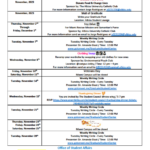Claudia Cedeno Nadal, Griela Rodriguez, Megan Patel, and Mei-Ling Villafana Abraham
In today’s digital era, technology is present in all aspects of our lives, including children’s. This has raised many questions and concerns about how technology affects the development of children’s brains. Neuropsychologists have extensively researched the complex relationship between technology and the developing mind. Their findings reveal both positive and negative effects of technology on child brain development. These insights can be valuable to parents, educators, and society as a whole, helping us understand the role of technology in children’s lives and guiding us in promoting healthy and balanced digital engagement. The research emphasizes the potential positive impact of technology on child brain development and provides a deeper understanding of the specific areas where technology can be beneficial. When used thoughtfully and intentionally, technology can be a powerful tool for children’s cognitive, educational, and social development.
One area where technology has shown its potential is in enhancing learning experiences. Educational apps and websites have emerged as valuable resources that engage children in interactive and immersive learning activities. These digital tools allow children to acquire new skills and knowledge in engaging and innovative ways. The interactive nature of educational apps fosters active participation, critical thinking, problem-solving, and creativity, all contributing to cognitive development and academic achievement.
Technology has played a significant role in fostering connectivity and social interaction among children. Digital platforms, social media, and communication tools have facilitated the ability for children to stay connected with friends and family, especially in situations where physical distance may be a barrier. Children can maintain relationships, share experiences, collaborate on projects, and develop critical social skills through virtual interactions. These digital connections contribute to developing communication skills, empathy, cultural understanding, and nurturing a sense of belonging and social support.
In addition, technology offers opportunities for children to explore diverse perspectives, cultures, and experiences that may not be readily available in their immediate environment. Online platforms and resources provide access to information, enabling children to broaden their horizons, expand their knowledge, and develop global awareness. This exposure to a wide range of ideas and perspectives can foster open-mindedness, tolerance, and the ability to navigate the complexities of our interconnected world. It is important to note that the positive impact of technology on child brain development relies heavily on the thoughtful integration and guidance provided by parents and educators. The key lies in actively selecting age-appropriate and educational content, setting boundaries and guidelines for technology use, and encouraging children to engage in a balanced range of digital and non-digital experiences. This holistic approach ensures that technology complements and enhances children’s overall development rather than becoming a passive or detrimental presence in their lives.
While technology brings numerous benefits to children’s lives, it also poses challenges that can impact child brain development. It is essential to be aware of the potential adverse effects and take necessary measures to mitigate them. One of the concerns associated with technology is the potential for excessive use of electronic devices, which can lead to addictive behaviors. Children may become overly dependent on technology, spending extended periods engaged in screen time activities to the detriment of other essential aspects of their lives. This excessive reliance on technology can disrupt crucial areas of well-being, including physical health, social interactions, and cognitive functioning.
Research has consistently highlighted the correlation between prolonged screen time and negative outcomes. Excessive technology use has been linked to difficulties in attention span, as the constant exposure to fast-paced and stimulating content can make it challenging for children to concentrate and sustain their focus on tasks that require sustained attention. This can affect their ability to learn, complete academic assignments, and engage in activities that demand mental effort.
The excessive use of electronic devices, especially before bedtime, can disrupt sleep patterns. The blue light emitted by screens has been shown to interfere with the production of melatonin, a hormone that regulates sleep. Children who engage with technology late at night may experience difficulty falling asleep, have disrupted sleep patterns, and consequently suffer reduced sleep quality. Sleep deprivation can cascade effects on cognitive performance, mood regulation, and overall well-being. Additionally, excessive screen time can lead to a sedentary lifestyle, reducing children’s time engaging in physical activities. This lack of physical activity can contribute to weight-related issues, such as being overweight or obese. Sedentary behavior combined with unhealthy snacking habits while using electronic devices can further exacerbate the risk of weight-related problems, which can have long-term implications for physical health and well-being.
To address these challenges, it is crucial to establish healthy boundaries and promote a balanced approach to technology use. Limiting screen time and encouraging children to engage in diverse activities, including physical exercise, social interactions, and creative play, is vital for their overall well-being and cognitive development. It is essential for parents, educators, and caregivers to be mindful of the potential risks associated with excessive technology use and to create an environment that promotes a healthy and balanced lifestyle for children. Understanding the effects of technology on child brain development requires us to consider various factors. The type of technology used, the duration of usage, and the child’s characteristics all play significant roles. Each child’s experience with technology is unique, and its impact can vary accordingly.
As parents and educators, we must be mindful of technology’s potential risks and benefits. Drawing upon valuable insights from neuropsychology, we offer the following guiding principles to navigate the digital landscape effectively:
- Encouraging children to participate in activities that require sustained attention is key to their cognitive development. By engaging them in hands-on activities, creative play, and outdoor exploration, we help them build crucial skills while limiting excessive screen time. Striving for a balance between technology use and other forms of engagement ensures their comprehensive cognitive growth.
- Creating specific areas or periods where electronic device use is strictly prohibited sets the stage for undisturbed attention and quality sleep—designating areas in the house, such as the dining table or bedrooms, as tech-free zones encourage face-to-face interaction and meaningful conversations. Similarly, enforcing tech-free times, such as during meals or family outings, promotes better focus and enhances social connections.
- Bedtime routines are essential for preparing children for restful sleep. Instead of relying on electronic devices, encourage activities that promote relaxation and calmness. Reading bedtime stories, engaging in soothing conversations, or practicing mindfulness exercises can help children unwind and transition into a peaceful sleep. Prioritizing restful sleep enhances their cognitive performance and contributes to their overall well-being.
- Teaching children about the significance of sleep is crucial. Help them understand how sleep affects their health and cognitive functioning. Explain the detrimental effects of technology use before bedtime, such as the disruption of sleep patterns and the impact on their ability to concentrate and learn. By emphasizing the need for uninterrupted, high-quality rest, children will develop an appreciation for the role sleep plays in their overall well-being.
References
American Academy of Pediatrics. (2016). Media and young minds. Pediatrics, 138(5), e20162591. doi:10.1542/peds.2016-2591
Anderson, C. A., & Dill, K. E. (2000). Video games and aggressive thoughts, feelings, and behavior in the laboratory and in life. Journal of Personality and Social Psychology, 78(4), 772–790. doi:10.1037/0022-3514.78.4.772
Hutton, J. S., Dudley, J., Horowitz-Kraus, T., DeWitt, T., Holland, S. K., & Einstein, D. A. (2015). Differences in functional brain network connectivity during stories presented in audio, illustrated, and animated format in preschool-aged children. Brain Imaging and Behavior, 9(1), 96–106. doi:10.1007/s11682-014-9282-x
Hale, L., Guan, S., & Screen time and sleep among school-aged children and adolescents: A systematic literature review. Sleep Medicine Reviews, 21, 50–58. doi:10.1016/j.smrv.2014.07.007
Kostyrka-Allchorne, K., Cooper, N. R., & Simpson, A. (2017). The effects of acute exercise on attentional bias towards smoking-related stimuli during temporary abstinence from smoking. Psychiatry Research, 257, 498–504. doi:10.1016/j.psychres.2017.08.03
About the Authors
Claudia Cedeno, M.S., BCaBA is working towards her doctorate in clinical psychology, focusing on child and adolescent psychology. Her passion for serving her community through clinical practice has led her to develop a particular interest in understanding the distinct needs and challenges children and adolescents face.
Griela Rodriguez, M.S., is a second-year graduate student pursuing a PsyD in Clinical Psychology with a concentration in Neuropsychology. She has a master’s degree in Exceptional Student Education, emphasizing Behavior Analysis. She has worked with children and adults with Developmental Disabilities since 2010 and the Defendants Program in the Agency for Persons with Disabilities. Throughout her work and studies, she has explored various theories and therapeutic approaches, gaining a deeper understanding of the causes and treatment of psychiatric disorders.
Megan Patel, M.S., is a second-year graduate student pursuing a PsyD in Clinical Psychology with a concentration in Neuropsychology. She has gained clinical experience in private practices by administering and interpreting assessments. She is particularly interested in working with children with Autism Spectrum Disorder and other Neurodevelopmental disorders. Her ultimate goal is to become a licensed Clinical psychologist specializing in Pediatric Neuropsychology, where she can provide comprehensive assessments, interventions, and support to children and families.
Mei-Ling Villafana Abraham, M.S, BCaBA, is a second-year doctoral student specializing in child and adolescent psychology. She believes that early treatment of mental health disorders in children is essential for promoting healthy development, preventing further issues, and improving their overall quality of life. Her passion lies in advocating for policies and practices that support the well-being of children, including access to healthcare, education, and other resources.










